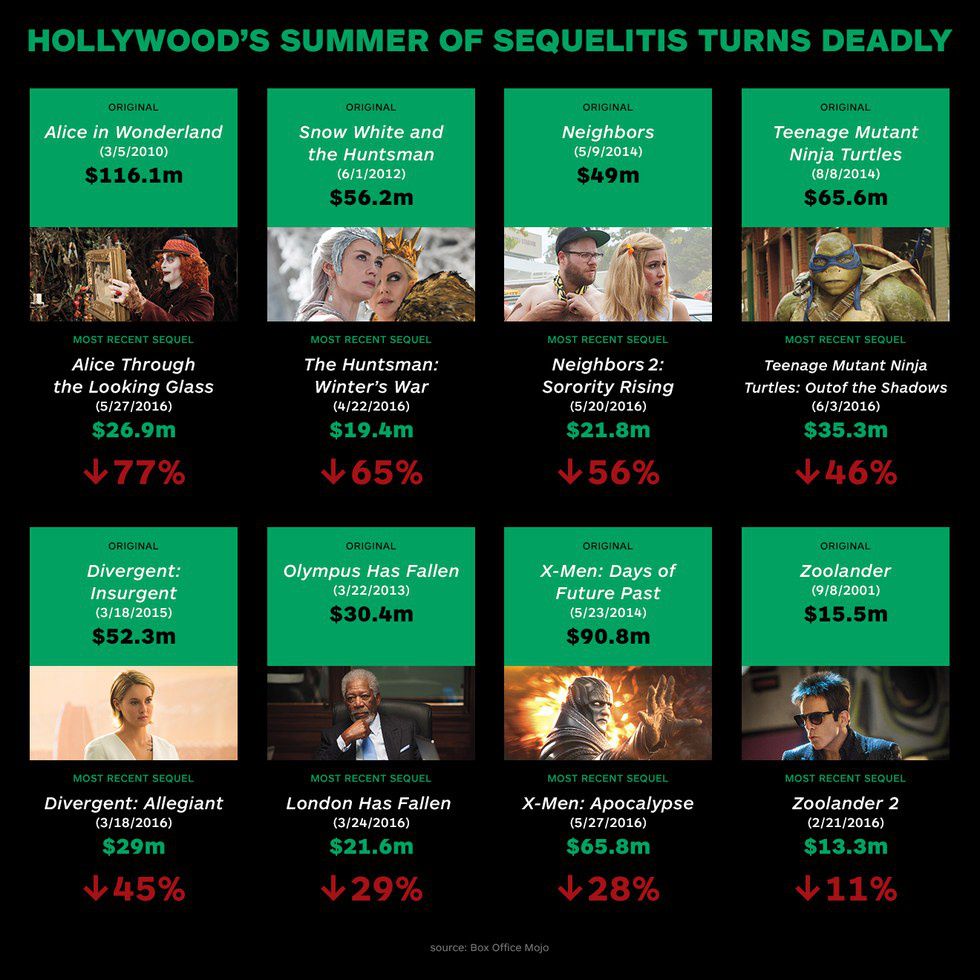Drive by a movie theater these days and the movies advertised all seem to be a sequel of some sort. Some of the sequels out right now include "Neighbors 2: Sorority Rising," "Alice Through the Looking Glass," "Teenage Mutant Ninja Turtles 2," "Now You See Me 2," "The Conjuring 2," and plenty more. It seems like 2016 has the movie industry relying on “The 2,” better known as the sequel. However, most of these movies don’t appear to live up to expectations, with low opening night sales and small box office figures domestically. With even more sequels set to come out this summer, including the highly anticipated "Finding Dory" (which comes out Friday, June 17), one must wonder what is causing these movies to be a bust.
Historically, sequels tend to make more money than the original film. When the first movie does well, producers begin to think of ways that they can make more money off their original idea. Producers go-to? The sequel. For many years, this has been a successful strategy. When moviegoers like the first film, they tend to want to see the second. No need to find the films audience because the movie already has it due to the original.
The success of this strategy was proven in 2011, when the top movies of the box office were all sequels. In 2015, "Pitch Perfect 2" beat the original in box offices sales by $172.1 million dollars. However, "Pitch Perfect 3" has been pushed back from its original release date of July 2017 to December 2017. The reasoning behind this move? Studios are nervous about sequels due to their sudden lack of success.
So far in 2016, the sequel has been a flop. Part of the reason for this sudden influx of mediocre movies with overdone characters and plots is because it is an easy money maker for the film industry. It isn’t cheap to produce a film, and most studios have to finance at one point or another. When the big movie studios need a go-to money maker, they make a sequel. Which means that if a movie even did moderately well, then there probably will be a sequel even though most of these stories should have ended long before the producers ever decided to make another.
The sequel that started it all for 2016 was "Ride Along 2." This comedy suffered at the box office with its opening weekend grossing $35,243,095, down from the opening weekend gross of $41,516,170 for the first "Ride Along." While there wasn’t much hope for this sequel in the first place, this is still atypical of the movie industry. In April, "Huntsman’s" domestic opening declined 65 percent from "Snow White and The Huntsman" from 2012. However, even internationally "Huntsman 2" suffered. With a foreign box office opening weekend total of $19,137,996 compared to $39,300,000 for the original, "Huntsman 2" seems to have fallen into the same slump as the rest of the 2016 sequels. The sequel is just not doing well domestically or internationally.
The success of original films like "Zootopia" and "The Jungle Book" prove that modern moviegoers don’t want to see the same washed up characters over and over again. "Zootopia" has grossed $1,001,141,519 and opening weekend made $75,063,401, and the live-action version of "The Jungle Book" has so far made $900,564,426. The opening weekend for "The Jungle Book" made $103,261,464 and is still playing in many theaters across the nation. This just goes to show the success of something different (even if, The Jungle Book was just a live-action version of the classic animation).
With the current sequels all tending to flop so far this year, it brings to question the fate of the rest of the sequels in line for 2016. There are still plenty of sequels left this year for the movie industry to redeem themselves. The question is will they be the blockbusters the film industry is looking for or will they join a long list of busts. Films like "Finding Dory" (anticipated to be Pixar’s largest opening yet) and "Independence Day: Resurgence" will show whether or not “The 2” will survive. Will 2016 be the end of the sequel? The coming months will tell.






















